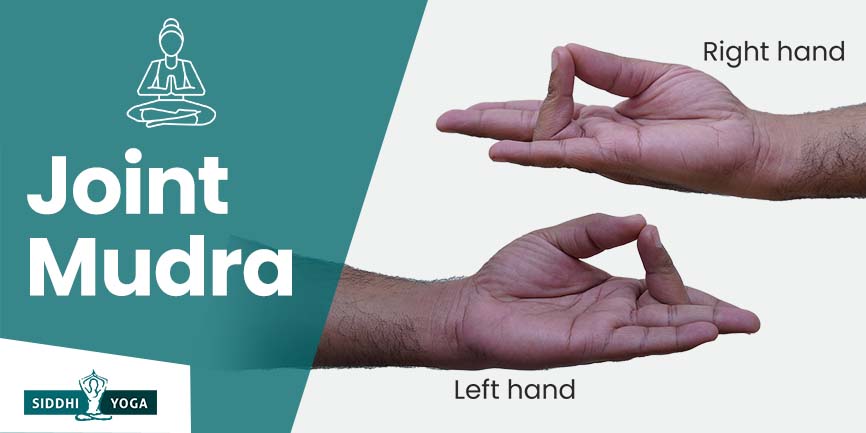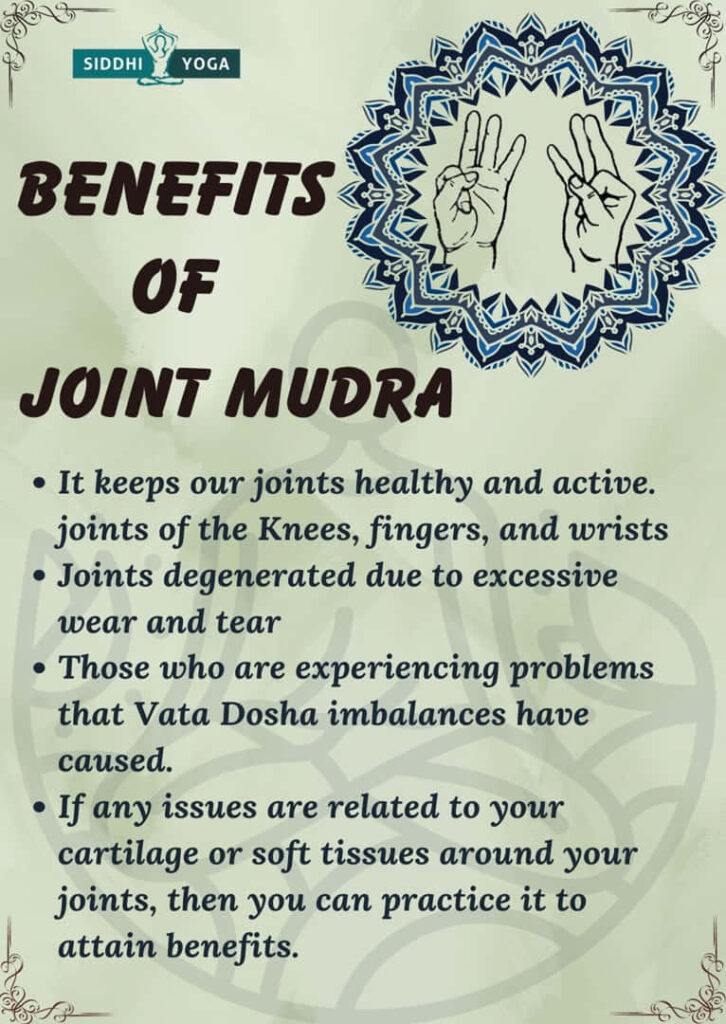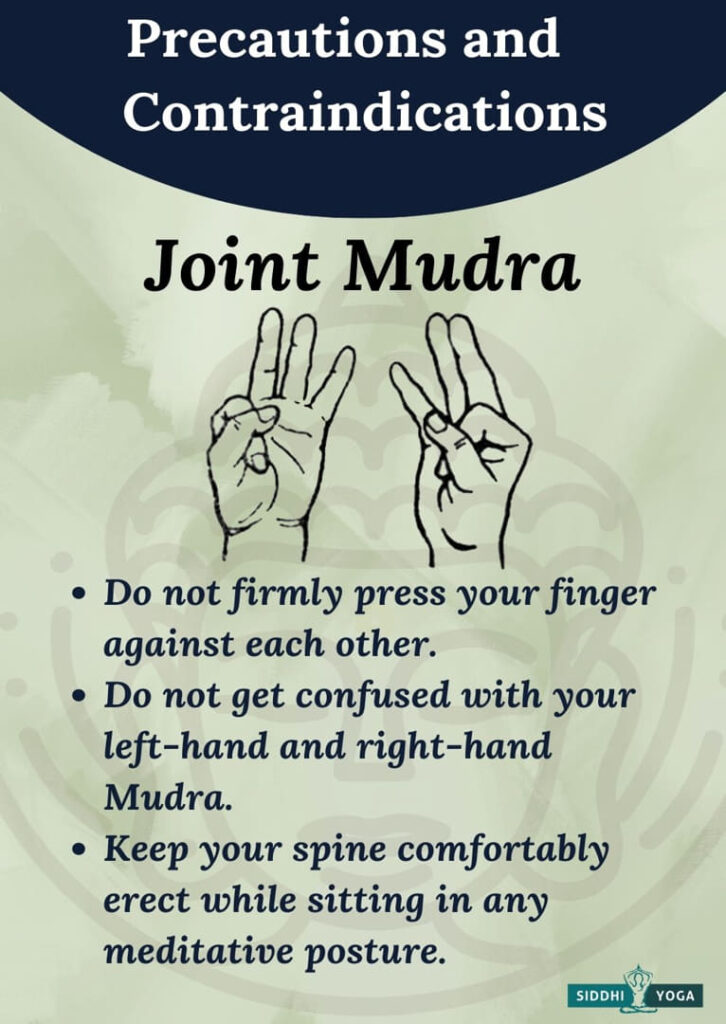
Joint Mudra is a yogic Mudra that is said to help with joint pain and arthritis. Learn about the meaning and benefits of Joint Mudra and how to do it in this comprehensive guide.
Definition – What is Joint Mudra and its Meaning, References, and Mythology?
Joint Mudra or gesture of Joint is a type of Hasta Mudra or hand gesture/seal. Joint Mudra is one of the Mudras that have different hand positions in both hands. This Mudra is also known as Sandhi Mudra. The word “Sandhi” represents “Joints.”
Joint/Sandhi is often used for the place where two or more bones come together to form a joint. Many of the Joints are moveable, often called Synovial joints or moveable joints. To allow proper movement formation, there are fluid in-between two bones. This allows pain-free and smooth movement between the bones. This Mudra or hand gesture helps to keep the joints stress-free and helps to keep them healthy.
Many different structures help in joint movement formation. One such is cartilage. Cartilages are made those structures that are slightly flexible and allow movement. Cartilages are found around each and every joint that we have. This Mudra is believed to be effective in keeping the cartilage healthy.
This Mudra is a combination of two Mudras, one of which is Prithvi Mudra. You have to keep Prithvi Mudra on your right hand. And the other one is Akash Mudra. You need to practice with your left hand. As this Mudra is a combination of these two Mudras, it is believed to help in Vata Dosha and helps keep our joints healthy.
It is believed that this Mudra is effective in Knee joint-related problems. However, this Mudra is also effective for other joints.
As we know, most Joint-related problems arise from wear and tear of the joint. And because of this, the gap between these joints starts to get shortened. This means these joints lack the Akash element (Space element). Practicing this Mudra positively affects joints with the help of the Akash element. This Mudra is very beneficial for ancient-age people or those with joint-related issues.
Alternate Name of Joint Mudra
Sandhi Mudra.
How to Do Joint Mudra?
- This Mudra can be practiced while holding different postures if you feel it is right for you to do so.
- However, to gain maximum benefits of this Mudra, start by sitting in a comfortable meditative posture (Sukhasana, Padmasana, or Swastikasana). Whichever posture you find comfortable while sitting is fine.
- Keep your neck and spine comfortably erect. We do not want any excessive arch in the back.
- Rest both of your palms comfortably on your knee. Palms facing upward towards the sky.
- Gently close your eyes.
- Now, on your left hand, gently join your middle finger and thumb to form a circle. All the remaining fingers of your left hand will remain comfortably extended.
- Then on your right hand, join your ring finger and thumb gently to form a circle. All the remaining fingers of your right hand will remain comfortably extended.
- Observe the space behind your eyes known as Chidakash or “Chitta ka Akash”. This dark space also represents the “Akash Tatva” (Space Element).
- Use your imagination to fill Chidakash with white or yellow light.
- Witness your inner self.
- Inhale and exhale slowly, do not rush to breathe. Take your full time to inhale and exhale.
- You can practice it with different Pranayama and various meditation techniques such as Humming Bee Pranayama (Bhamri Pranayama) & Chandra Bhedi Pranayam (Left Nostril Breathing).
Joint Mudra Benefits

- It keeps our joints healthy and active. Specially joints of the Knees, fingers, and wrists
- Joints degenerated due to excessive wear and tear, and those joints where two bones have come close enough that they started hurting due to friction caused by them can benefit from the help of this Mudra practice.
- Those who are experiencing problems that Vata Dosha imbalances have caused.
- If any issues are related to your cartilage or soft tissues around your joints, then you can practice it to attain benefits.
Joint Mudra Precautions and Contraindications

Similar to all other Mudra practices, it has no side effects.
However, there are a few things to consider:
- Do not firmly press your finger against each other. They should be slightly touching each other and not put excessive pressure.
- Do not get confused with your left-hand and right-hand Mudra, as they are both different, so one can quickly get confused.
- Keep your spine comfortably erect while sitting in any meditative posture.
When and how long to do Joint Mudra?
- Those who experience Vata imbalance should practice it.
- If you have diseases that are related to your joints.
- This Mudra can be practiced when you feel imbalances caused by space elements in your body.
- You can practice this if you want to a greater state in meditation.
- If any issues are related to your cartilage or soft tissues around your joints, then you can practice it.
Morning is the ideal time to do any yoga or Mudra. In the morning, during the daytime, our brain is at its best. So, you are more likely to be able to concentrate easily. Therefore, you should practice this Mudra from 4 am and 6 am to get the most effective outcomes.
If you are having difficulty with this during the morning, you can do this Mudra later in the evening too.
Do as per the requirements, or four times a day for 15 minutes. Whether you wish to complete it in one stretch or two threes that last between 10 and 15 minutes, it’s up to you. Based on research, the best way to practice an exercise for at least 20 minutes is to get the best benefits of that particular Mudra. This Mudra should be held six times a day for 30 minutes in case of joint aches and pains.
Breathing in Joint Mudra
There are three types of breathing we can practice with this Mudra.
- Abdominal Breathing.
- Yogic Breathing (Abdominal Breathing, Thoracic Breathing & Clavicle breathing).
- Slow Breathing.
Visualization in Joint Mudra
- Visualize that you are in space.
- Your joints are unaffected by gravity.
- Nothing is weighing you down.
- Your joints are happy.
- You are experiencing joy.
Affirmation in Joint Mudra
While practicing this, Keep a positive intention. Start with:
“I am in love with my flexibility. I am thankful for my joints and will care for them.”
Conclusion
The Joint Mudra is a powerful tool that can be used to ease pain in the joints and connective tissue. You can improve your overall joint health and function by performing this Mudra regularly. If you’re interested in learning more about Mudras and how to use them effectively, consider taking our Mudras Certification Course. This course covers all 108 Mudras and provides expert guidance on when and how to use each one for maximum benefit.